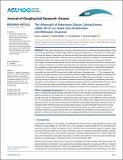Files in this item
The aftermath of Petermann Glacier calving events (2008-2012) : ice island size distributions and meltwater dispersal
Item metadata
| dc.contributor.author | Crawford, Anna J. | |
| dc.contributor.author | Mueller, Derek | |
| dc.contributor.author | Desjardins, Luc | |
| dc.contributor.author | Myers, Paul | |
| dc.date.accessioned | 2019-06-04T23:39:44Z | |
| dc.date.available | 2019-06-04T23:39:44Z | |
| dc.date.issued | 2018-12 | |
| dc.identifier | 257600562 | |
| dc.identifier | 7089930f-aca2-41da-a5dc-243a4a499b3a | |
| dc.identifier | 85057744920 | |
| dc.identifier.citation | Crawford , A J , Mueller , D , Desjardins , L & Myers , P 2018 , ' The aftermath of Petermann Glacier calving events (2008-2012) : ice island size distributions and meltwater dispersal ' , Journal of Geophysical Research: Oceans , vol. 123 , no. 12 , pp. 8812-8827 . https://doi.org/10.1029/2018JC014388 | en |
| dc.identifier.issn | 2169-9275 | |
| dc.identifier.uri | https://hdl.handle.net/10023/17814 | |
| dc.description | The project received funding from Environment and Climate Change Canada and Polar Knowledge Canada, both within the Government of Canada, as well as funding for computing resources by the Canada Foundation for Innovation and the Ontario Research Fund. | en |
| dc.description.abstract | Three large calving events occurred at Petermann Glacier in northwest Greenland between 2008 and 2012 that generated ice islands (large tabular icebergs) that ranged from ~30 to 300 km2 in areal extent. Ice islands are known to deteriorate, via fracture and melt, during their drift through regional water bodies where they pose a potential risk to offshore resource extraction operations and disperse freshwater from the Greenland Ice Sheet. This study presents the first analysis of the deterioration occurring across the flux of ice islands that travel between Nares Strait and the North Atlantic after Petermann Glacier calving events. The evolution of Petermann ice island size distributions was evaluated, and the spatial dispersal of meltwater was quantified, through analyses that utilized the newly developed Canadian Ice Island Drift, Deterioration and Detection Database. Size‐frequency distributions remained relatively consistent, both spatially and temporally, and were well fit by power law models with slopes of approximately −1.7. This suggested that fracture was an important process by which the Petermann ice islands deteriorated, regardless of elapsed time or distance from the glacier. Ice island meltwater fluxes into the Baffin Island and Labrador currents were not large enough to slow down the Atlantic Meridional Overturning Circulation by weakening deep‐water convection in the Labrador Sea. However, augmented meltwater input was calculated within Petermann Fjord (2.0 mSv) and in the vicinity of grounding locations (0.4 mSv). Further research is necessary to better understand how this freshwater alters fjord circulation and influences the composition of local ocean waters. | |
| dc.format.extent | 16 | |
| dc.format.extent | 2183179 | |
| dc.language.iso | eng | |
| dc.relation.ispartof | Journal of Geophysical Research: Oceans | en |
| dc.subject | Ice islands | en |
| dc.subject | Icebergs | en |
| dc.subject | Freshwater flux | en |
| dc.subject | Petermann Glacier | en |
| dc.subject | Ice hazards | en |
| dc.subject | Calving | en |
| dc.subject | GE Environmental Sciences | en |
| dc.subject | DAS | en |
| dc.subject.lcc | GE | en |
| dc.title | The aftermath of Petermann Glacier calving events (2008-2012) : ice island size distributions and meltwater dispersal | en |
| dc.type | Journal article | en |
| dc.contributor.institution | University of St Andrews. School of Geography & Sustainable Development | en |
| dc.identifier.doi | https://doi.org/10.1029/2018JC014388 | |
| dc.description.status | Peer reviewed | en |
| dc.date.embargoedUntil | 2019-06-05 |
This item appears in the following Collection(s)
Items in the St Andrews Research Repository are protected by copyright, with all rights reserved, unless otherwise indicated.

